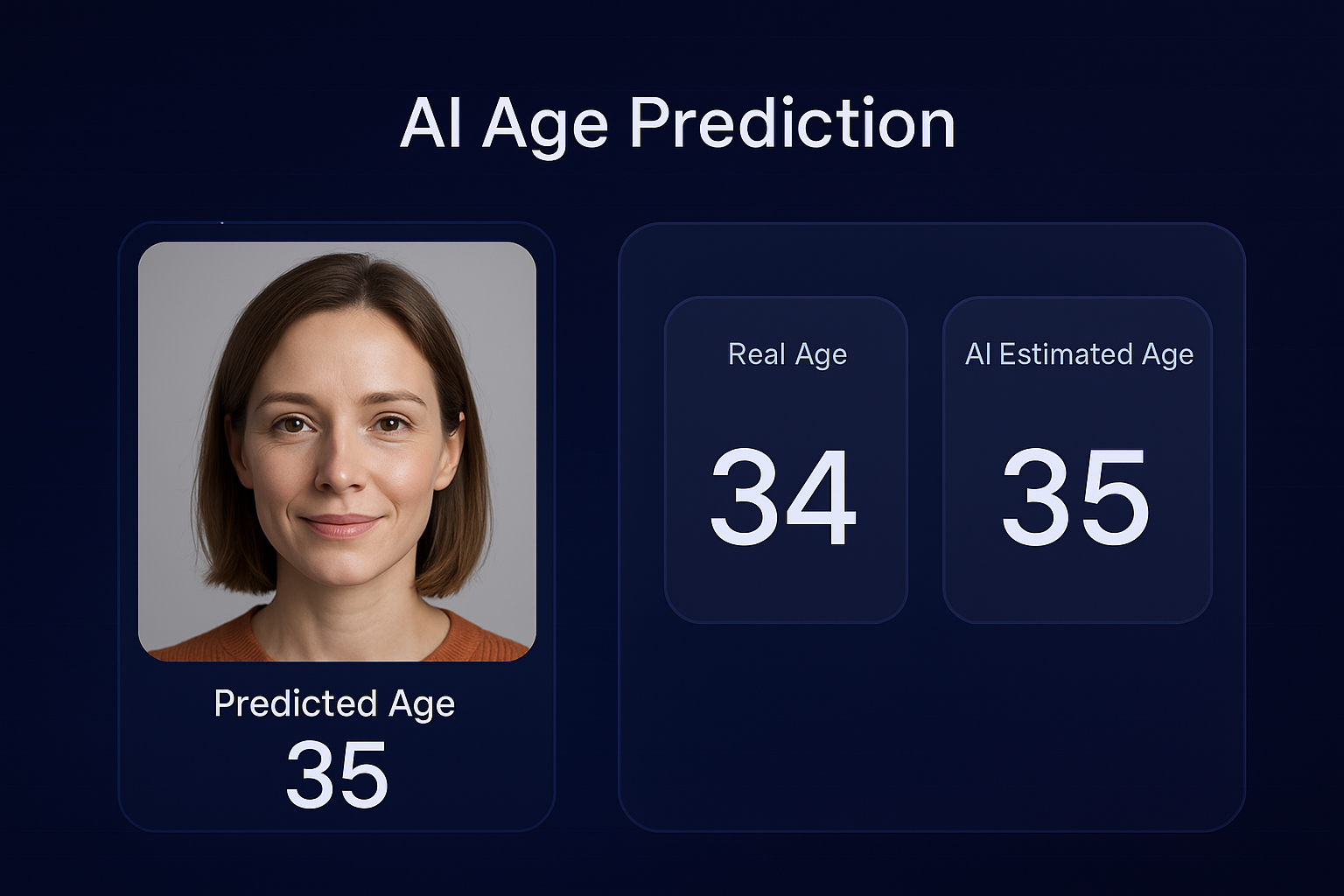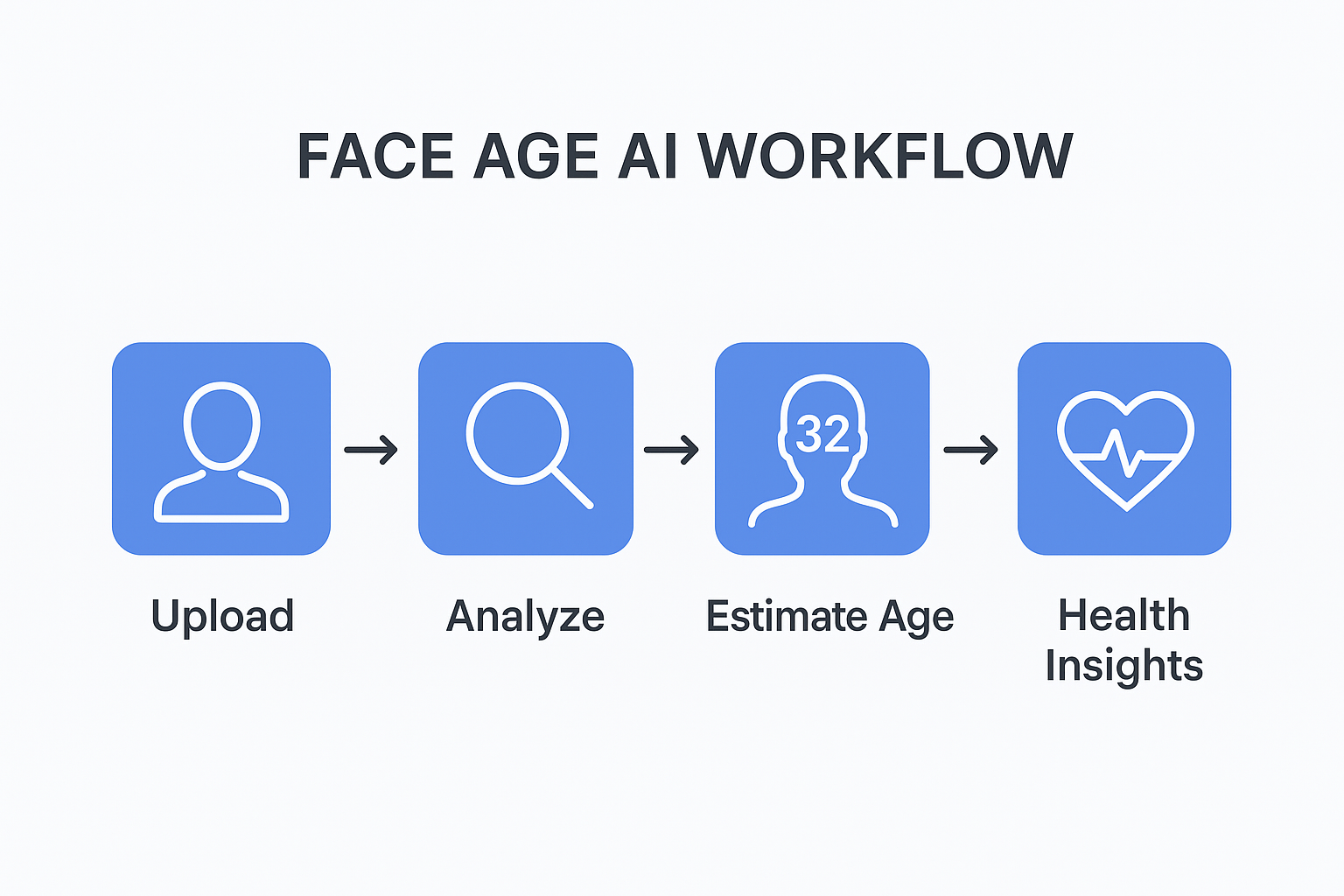Face Age AI: How Face Photos Estimate Age and Hint at Health Insights
Short version: face age AI uses computer vision to read patterns in a selfie—wrinkles, texture, symmetry—and estimates perceived age. Early research shows these cues can correlate with health, but they are not a diagnosis. If you want to try it, FaceAge AI runs the analysis without storing your photo.

What is face age AI?
Face age AI refers to models trained on large, diverse face datasets to estimate how old someone appears in a single image. The system detects a face, maps landmarks, and analyses features such as skin texture, eye area, smile lines, and overall symmetry. It then compares these patterns against examples it has learned and outputs an estimated age.
Unlike the playful “guess my age” tools of the past, today’s face age AI benefits from stronger data, better augmentation, and careful evaluation. Results are more consistent, and the models are robust to typical photo quirks like lighting and angle—within reason. That said, the estimate reflects what you look like in that image, not your legal birthday or your medical status.
Why people search for “AI face photos tool estimate age predict cancer outcomes”
- People want a reliable age estimate from a selfie.
- Some are curious whether facial aging signals relate to long‑term health.
- Others look for credible research and an easy tool to try.
This mix of needs explains the rise of the term and the interest in platforms such as FaceAge AI. Our faces do carry markers of biological aging, and researchers are exploring how these relate to health trajectories. But there is an important line between interesting correlations and clinical diagnosis.
From fun to thoughtful insight
Most users meet face age AI through a simple question: “How old do I look?” The experience is satisfying because it feels immediate and visual. Over time, the conversation has shifted from fun only to curiosity about wellness: does looking older than peers reflect sleep, sun exposure, stress, or lifestyle? Could an algorithm flag accelerated aging that deserves attention?
Studies in computer vision and epidemiology suggest that perceived age and certain facial features can correlate with cardiovascular risk, metabolic health, and some cancers. Correlation, however, is not causation. A face age AI result should be treated as an educational signal, not a verdict. If a tool nudges someone to review habits—sunscreen, sleep, nutrition—or to consult a professional, it has already created value without pretending to be a medical device.
How AI face photo tools estimate age (in plain language)
- Face detection: find the face and crop it for consistent analysis.
- Landmark mapping: locate eyes, nose, mouth, jawline, and other anchor points.
- Feature extraction: quantify texture, fine lines, pigmentation variation, and symmetry.
- Model prediction: compare the pattern to learned examples and output an age estimate.

More advanced systems distinguish between chronological age (years lived) and apparent age (how old you look) and can highlight markers of accelerated aging. This is why interest in queries like “ai face photos tool estimate age predict cancer outcomes” is growing. People don’t just want a number—they want context they can act on.
Why try FaceAge AI
FaceAge AI focuses on three things: clarity, privacy, and practical value.
- Accurate, instant estimates: upload a single selfie and get an age estimate in seconds.
- Future and past views: generate tasteful, photorealistic variations to see yourself older or younger.
- Privacy first: photos are processed in memory and not stored. Learn more on our Privacy page.
- Thoughtful guidance: gentle tips on habits linked to skin aging and overall wellness—no scare tactics, no medical claims.
If you’re curious what your face may be signalling, FaceAge AI offers a safe, fast way to explore.
Practical tips for a better result
- Use natural, even light. Avoid harsh backlight or heavy shadows.
- Keep the camera at eye level; look straight ahead.
- Remove sunglasses and heavy filters; light makeup is okay.
- Upload a clear, recent photo; avoid extreme angles.
These basics help any face age AI system read the same cues a person would notice in real life.
Ethics and limits you should know
- Not a diagnosis: face age AI is not a medical device and does not determine cancer risk or any disease.
- Bias awareness: training data quality matters. We continuously evaluate performance across ages, skin tones, and lighting conditions.
- Meaningful consent: tools should explain what they do and what they don’t. You deserve clear privacy practices and the option to delete data—FaceAge AI avoids storage by design.
Frequently asked questions
Does face age AI predict cancer outcomes?
No. Research explores links between facial aging markers and health, but predictions about cancer belong in clinical settings. Treat any “insight” as a prompt for healthy habits or a conversation with a professional.
How accurate is the age estimate?
It’s an estimate of perceived age based on one photo. Good lighting and framing can reduce noise and produce a more stable result.
Is my photo stored?
With FaceAge AI, no. Images are processed transiently and then discarded. See Privacy for policy details.
Can I try different ages?
Yes. You can generate tasteful future/past looks and compare them side by side.
Give it a try
Curious what your selfie says? Open FaceAge AI on the homepage, upload a photo, and see your estimated age instantly. Use the result as a light‑touch nudge toward better habits—sun protection, sleep, and stress management—rather than as a diagnosis.
Suggested visuals:
- A clean dashboard showing a selfie with the estimated age and confidence band.
- A simple workflow graphic: upload → analyze → estimate age → optional lifestyle tips.